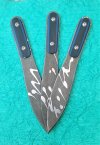- Joined
- Sep 29, 2019
- Messages
- 4
Hello, My name is Shannon Davidson, and I am an urban/epic fantasy writer. I'm currently working on a scene in my novel where one of my characters is trying to teach a young man how to hit a high target (15 feet) with throwing knives. The kid can do it at eye level, but doesn't seem to be able to judge the throw at an elevated height. (Yes, there's a reason he has to do it high).
His mentor claims that nothing is different; the rotation is the same, the distance is the same, the technique is the same, etc. But I don't think that's right. If a target were raised to 15 feet high instead of at eye level, how would you make the adjustment? If it's higher, I believe there would be a greater distance to the target. Correct? If so, how do you compensate?
(Pretty sure this is one of those geometry/algebra problems my math teacher warned me about.)
Thanks for any thoughts
His mentor claims that nothing is different; the rotation is the same, the distance is the same, the technique is the same, etc. But I don't think that's right. If a target were raised to 15 feet high instead of at eye level, how would you make the adjustment? If it's higher, I believe there would be a greater distance to the target. Correct? If so, how do you compensate?
(Pretty sure this is one of those geometry/algebra problems my math teacher warned me about.)
Thanks for any thoughts

